Redlines.
It’s just a word but if you are in certain circles, it’s a powerful word. “Redlines” is all you have to say to either send some into some form of post traumatic stress disorder while the face of others will light up as if you just said “You’ve won the lottery!” … I probably fall somewhere in the middle.
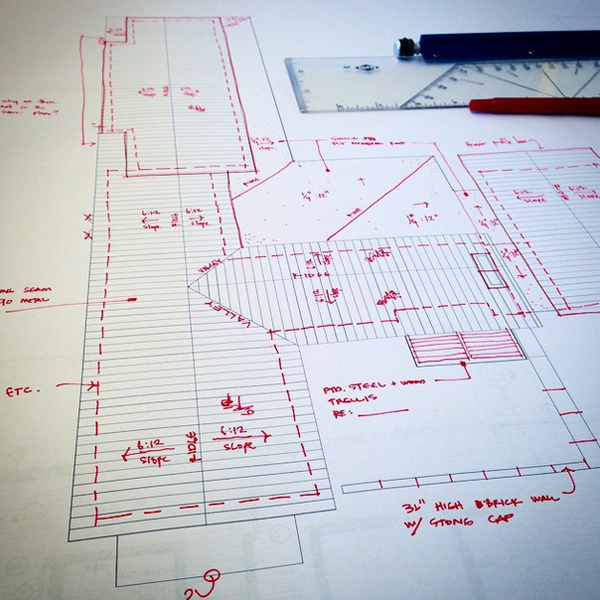
In case you don’t know, “Redlines” is the word used in an architectural office to reference the red ink that is typically used to mark up corrections that need to be made on architectural drawings. The red seems to be important as I have heard all sorts of variations along the lines of “I’m going to bleed all over these drawings” or “these drawings are so bad, I’m going to make them bleed”. Hmmm. That’s never been my attitude towards redlines, I just think the red is easier to see than black or blue marks.
I spent a few days last week redlining the drawings for the house that I used in my “Sketching during Schematic Design” post a few months back and thought it would be a good time to introduce the practice of redlining drawings in an architectural office as well as clarify my thoughts on what I think redlines are and what they are not.
We have a bunch of fairly young people in our office. All are talented and gifted young architects (or soon-to-be architects) but that doesn’t mean they know everything. If there is one thing I’ve learned about being a practicing architect for 20+ years is that any architect who thinks they know everything, clearly does not know everything. The field of architecture is extremely fluid and construction techniques and products are constantly changing – what was the correct way to do something a year ago might not be the best way any longer.

When I do spend time redlining drawings, I typically approach the process as an educational one rather than me telling someone how to properly do something. About half of the redlines I create have nothing to do with what is right or wrong – it’s my way of designing. I will typically encourage people in the office to take a stab at solving a problem before it comes to me, other times it’s me doing something as simple as laying out the lighting on a reflected ceiling plan for someone else to enter in to the computer (as the picture above would illustrate.)
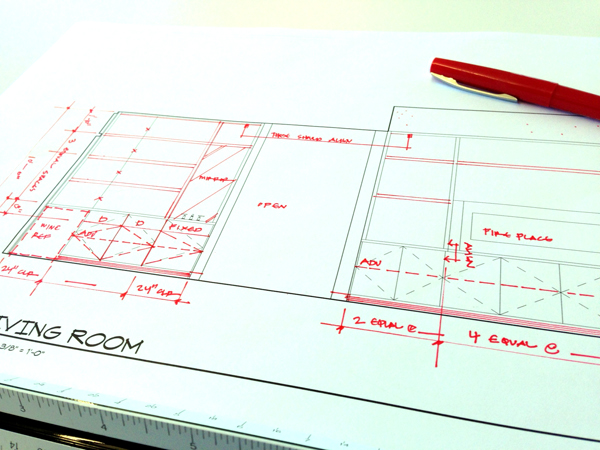
Sometimes the redlines are a commentary on the graphic presentation and technique indicated on the printed out drawing. At times, the people doing the drawing don’t have a lot of face time with clients during design development and don’t make the mental connection between the drawings we create and the abilities of the people we are “selling” them to – the clients. If the drawing looks terrible, the clients might spend their time trying to figure what the heck they are looking at rather than what we want them to be looking and thinking about. For example ..
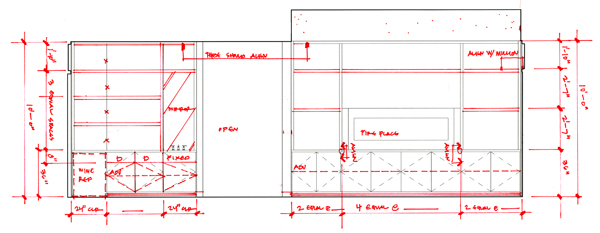
Take this elevation of a living room wall and an accompanying wet bar. The wet bar is on the left-hand side of the drawing above and there is a wood panel seam indicated vertically aligning with the righthand edge of the under-counter wine refrigerator. Normally I would be really happy about this line … it tells me that the person who drew this elevation is thinking about how it would actually be built. [wiping away tear …] I’m so proud! but I don’t want it in this particular drawing at this particular point in time. The owners are going to see that line and think “What is this line here?” Even if it is a wood panel seam, it wouldn’t be as visible as this dark line would indicate … we are burying the point of this drawing, which is does it work the way the owners want it to work? … not where the wood panel seams are located.
Make sense?
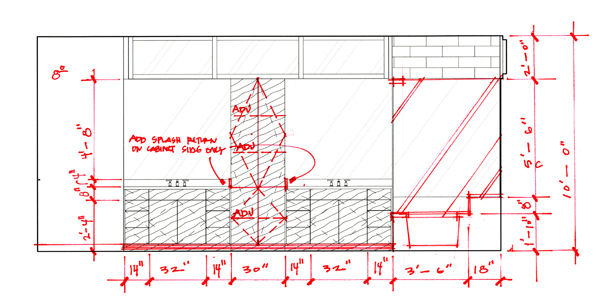
There are people – we’ll call them “old architects” – who are crazy for redlines; the ones who would rather create a few more redlined drawings rather than go down to the state comptroller’s office to collect their lottery winnings. (if that’s where you go to collect your lottery winnings …). As long as my message is delivered, I’m not really all that concerned with certain drawing conventions. In fact, I posted a picture of a redlined drawing on Facebook the other day and some people lost they minds over the fact that I wrote my dimensions to be read from the left.
Guess what? I don’t care. I’m left-handed and it’s simply easier for me to write them that way. I think if that’s the point of your redlines … [shudders]. I’m trying to create designers who think about my message over the means of delivery. I’m not saying drawing conventions aren’t important – I have my own conventions that I prioritize – but doing things simply because that’s how they’ve always been done smacks of dogma and I have no interest.
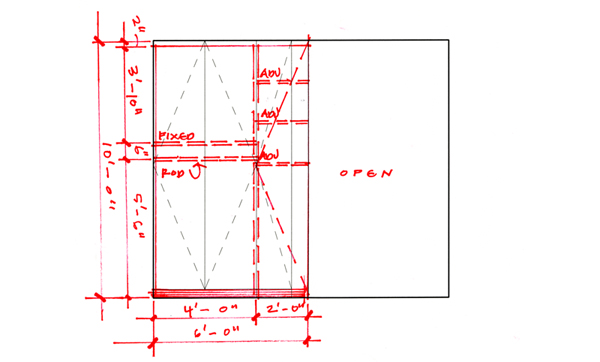
I’ll share a little story with you about redlines that I think went a long way towards forming the attitude I currently hold. I once worked in an office where there was a redline sensei, a true redline master!. I have a lot of respect for this particular architect, and he definitely knew what he was talking about, so if he wrote a redline on one of your drawings, you didn’t question it, you just did it. His redlines weren’t wishy-washy, they were clear, concise and thorough. Sounds kind of ideal right?
Wrong. It was terrible.
Everyone who worked with this particular architect stopped using their brains when it came to picking up his redlines. If this architect dropped his red pen and it left a line on the paper, that accidental mark would assuredly end up in the CAD drawings. Maybe there’s some hyperbole to that but not by much. People just went through the motions and if he drew a light fixture in a spot, you put it there. I think this process halted the learning process – unless you count osmosis as a viable learning process … which I don’t.
I don’t ever want the people I work with to do what I ask them to do without thinking about what it is they’ve been asked to do. I run through about 30 tasks a day and I jump on and off projects all day long so the likelihood that I make a redline mark that makes sense in one particular drawing, but doesn’t fit in with some other higher level item, is a real possibility. I want people to spend their mental resources thinking about what I am asking them to do rather than simply doing what I’ve told them to do. Some might call that being lazy but I like to call it teaching.
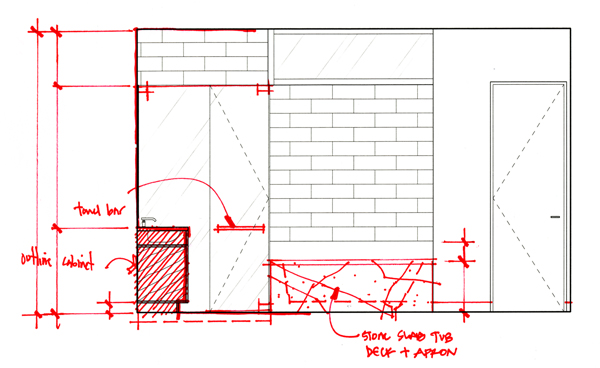
The more I can use redlined drawings as an opportunity to teach someone what I am thinking – talking through the marks on the page – the better the chances are that the person picking up those redlines will understand the redline and the less likely they are to produce a drawing that would require a similar redline mark in the future.
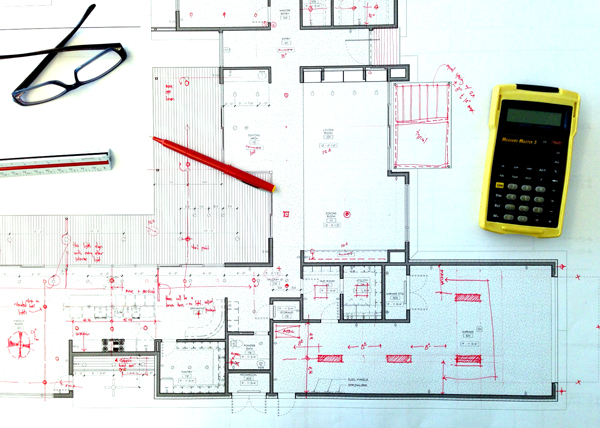
If you look at the lighting plan above, I didn’t just draw in the lights and move on – there is a running commentary going on. I ask questions, ask for opinions – I want the redlines to not simply be a reflection of what I want to see happen, I want the redlines to help create ownership of the design with the people who are working on the project.
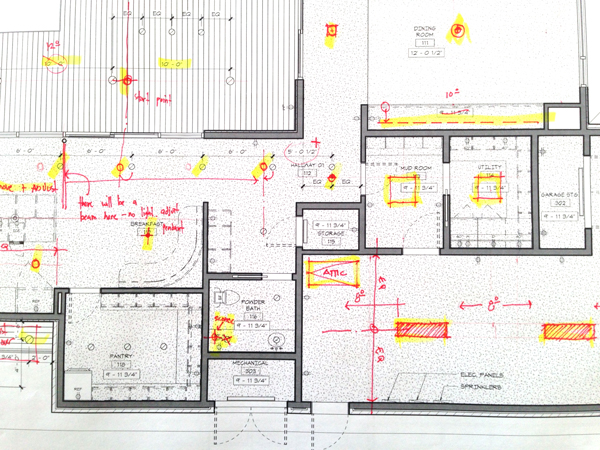
This is the same lighting plan after some of the redlines were picked up – indicated by the highlighter marks (yellow means “completed”)
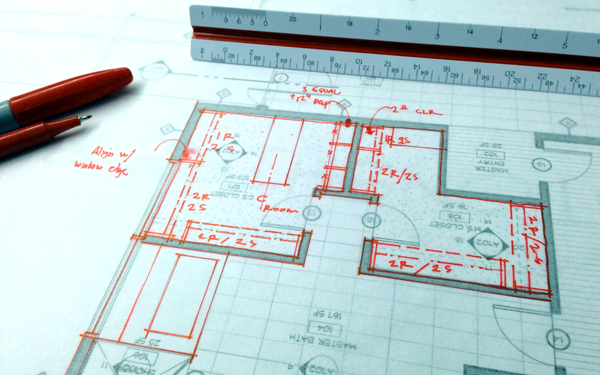
Finally, redlines are also another chance to review the design. In the plan above of a Master Bedroom closet, by this time, I am putting some redlines on the drawings that has already been vetted out several times. I drew it once by hand, someone else entered it into the computer, the owner has seen it several times, yet, here I am redlining the plan and modifying/clarifying how the closet will be laid out.
Redline marks don’t always represent what is wrong, sometimes they simply represent another opportunity to make something better … certainly something more considered and resolved. They are an important part of the natural evolutionary design process; how you shoos to use them is up to you.
Happy redlining,

p.s. because I know some people have already asked, I typically use Sharpie Ultra fine and Fine tipped pens for my redlines. Depending on the type of redline, I will also use a red pencil to ghost in my solution as I move through the process before I make it a bit more permanent with pen.

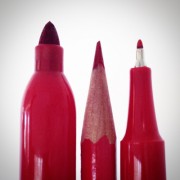


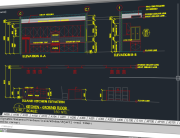



Recent Comments